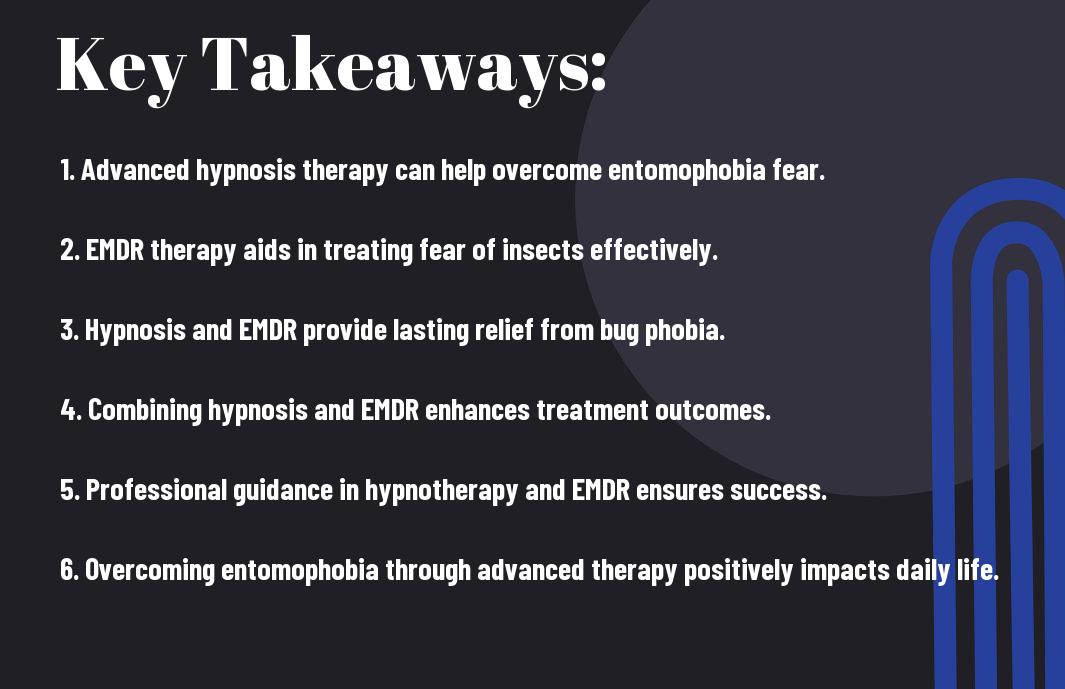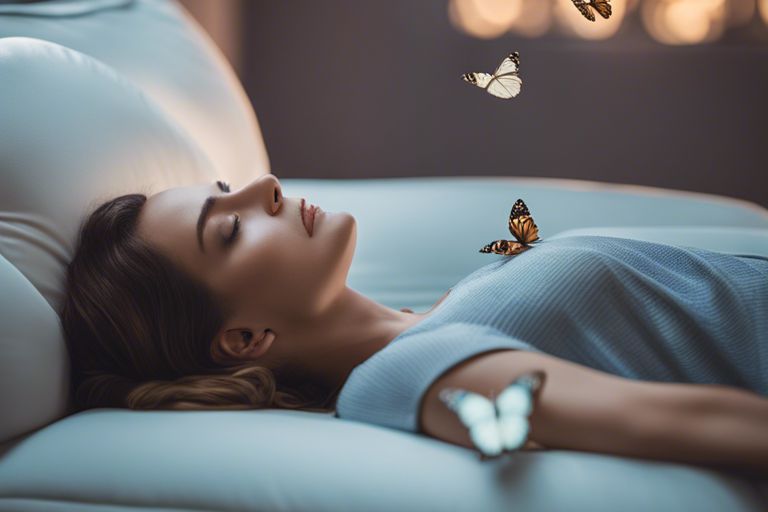Advanced Hypnosis therapy and EMDR for the relief of bugs.
You may think that Entomophobia, the fear of insects, is just a minor inconvenience. However, for those who struggle with this phobia, the impact on daily life can be immense. Anxiety, avoidance behaviours, and panic attacks are just a few of the challenges faced by individuals with entomophobia. Fortunately, there are effective therapies available to help overcome this fear. Hypnosis therapy and EMDR (Eye Movement Desensitization and Reprocessing) have shown promising results in treating specific phobias, including the fear of bugs.
By addressing the root cause of the fear and using techniques to reframe perceptions and responses, individuals can experience significant improvement in their symptoms. If entomophobia is interfering with your quality of life, exploring advanced hypnosis and EMDR therapies may be the key to overcoming this debilitating fear.
Key Takeaways:
- Hypnosis therapy: Advanced hypnosis therapy, such as hypnotherapy, can be an effective treatment for entomophobia (fear of insects).
- EMDR: Eye Movement Desensitization and Reprocessing (EMDR) is another therapy option that can help individuals overcome their fear of bugs.
- Exposure Therapy: Along with hypnosis and EMDR, exposure therapy can be utilized to gradually introduce individuals to insects in a controlled setting.
- Benefits: These therapies can help individuals manage their anxiety, reduce avoidance behaviours, and improve their quality of life.
- Professional Guidance: Seeking help from mental health professionals experienced in treating specific phobias is important for personalized and effective treatment.


The Science of Phobias
Definition and Types of Phobias
The fear of bugs, known as Entomophobia, is a specific phobia that falls under the category of anxiety disorders. Phobias are characterized by an overwhelming fear of a particular object or situation, which is disproportionate to any actual danger posed. There are various types of phobias related to insects, such as Apiphobia (fear of bees), Arachnophobia (fear of spiders), and Katsaridaphobia (fear of roaches). People with entomophobia may experience symptoms like excessive anxiety, avoidance behaviours, and physical reactions when exposed to insects. Any individual can develop a phobia, with genetic predisposition, traumatic experiences, and learned behaviours being common contributing factors.
| Apiphobia | Fear of Bees |
| Arachnophobia | Fear of Spiders |
| Katsaridaphobia | Fear of Roaches |
| Specific Phobias | Related to Insects |
The Biological and Psychological Basis of Entomophobia
Science suggests that entomophobia, like other specific phobias, has both biological and psychological underpinnings. The fear response to insects can be linked to past traumatic experiences, genetic factors, and learned behaviours. Individuals may develop panic attacks, avoidance behaviours, and physiological symptoms like increased heart rate and sweating when confronted with insects. Additionally, the brain’s amygdala, responsible for processing emotions, plays a significant role in triggering fear responses. Understanding the biological and psychological components of entomophobia is crucial in developing effective treatment strategies.
Basics of Hypnosis
Historical Background of Hypnosis in Therapy
Background: For centuries, hypnosis has been used as a therapeutic tool to address various psychological issues, including phobias. Historical records show that hypnosis has been utilized to treat fears and anxieties, providing a unique approach to managing specific phobias, such as entomophobia, or the fear of insects. The application of hypnosis in therapy has evolved, with modern techniques focusing on empowering individuals to overcome their deep-rooted fears.
How Hypnosis Can Address Phobias
Hypnosis: For individuals struggling with phobias like entomophobia, hypnosis therapy offers a promising solution. Hypnosis can tap into the subconscious mind, where fears and anxieties are deeply rooted, providing a safe and effective method to reframe negative beliefs and emotions associated with insects. Through hypnotherapy, individuals can experience a shift in perception, allowing them to confront their phobias with confidence and courage.
Another benefit of hypnosis therapy is its ability to address the underlying causes of phobias, such as past traumatic experiences or environmental triggers. By exploring the root of the fear within a supportive hypnotherapeutic environment, individuals can gain insight into their phobia and work towards resolving it.
The Process of Hypnotherapy for Phobic Disorders
On: The process of hypnotherapy for phobic disorders involves a skilled hypnotherapist guiding individuals into a relaxed state of heightened suggestibility, where they can access their subconscious mind. During hypnosis sessions, individuals are led through visualization techniques and positive affirmations to reframe their perceptions of insects. This process allows for the reprogramming of the individual’s response to insects, ultimately reducing fear and anxiety levels.
Process: With the incorporation of advanced hypnosis techniques and Eye Movement Desensitization and Reprocessing (EMDR), individuals can experience a comprehensive approach to overcoming their phobias. By combining the power of hypnosis therapy with EMDR, individuals can achieve lasting relief from their fears and regain a sense of control over their lives.
Advanced Hypnosis Techniques
All individuals struggling with entomophobia can benefit from advanced hypnosis techniques to overcome their fear of bugs. These techniques can be powerful tools in helping individuals manage their anxiety and ultimately conquer their phobia. For further reading, The Treatment of a Woman with Emetophobia: A Trauma… can provide valuable insights into the application of hypnosis therapy for specific phobias.
| Progressive Relaxation and Visualization | Direct and Indirect Suggestions for Overcoming Fear |
| Techniques such as progressive relaxation and visualization can help individuals with entomophobia relax their minds and body. By gradually releasing tension and imagining peaceful scenes, individuals can create a sense of calmness and reduce anxiety levels. | Direct and indirect suggestion techniques play a crucial role in helping individuals overcome their fear of bugs. Through carefully crafted verbal cues and subtle messaging, hypnotists can guide individuals toward replacing fearful thoughts with positive affirmations. |
This subset of advanced hypnosis techniques focuses on addressing the root cause of entomophobia and reshaping ingrained beliefs surrounding insects. By implementing a combination of direct and indirect suggestions during hypnosis sessions, individuals can start to rewire their subconscious minds and develop a more positive outlook toward insects.
Post-Hypnotic Suggestions and Reinforcement
The utilization of post-hypnotic suggestions and reinforcement is a fundamental aspect of advanced hypnosis therapy for entomophobia. By implanting positive suggestions during hypnosis that are activated post-session, individuals can continue to benefit from the therapeutic effects of hypnosis long after the session ends.
The implementation of post-hypnotic suggestions and reinforcement ensures that individuals with entomophobia have ongoing support and reinforcement to help them maintain their progress and build resilience against future triggers.
Customizing Hypnosis to Individual Needs
Progressive customization of hypnosis therapy to suit individual needs is important in addressing the unique experiences and triggers that contribute to entomophobia. Tailoring hypnosis sessions based on personal fears, experiences, and responses can maximize the effectiveness of the treatment and promote lasting positive change.
Post-hypnotic reinforcement techniques can be specifically tailored to address individual fears and concerns related to insects, providing a personalized approach that enhances the overall efficacy of the treatment.

Fundamentals of Eye Movement Desensitization and Reprocessing (EMDR)
Origins of EMDR Therapy
Many individuals seek out Eye Movement Desensitization and Reprocessing (EMDR) therapy to address deep-rooted fears and anxieties, such as entomophobia – the fear of insects. This innovative therapy approach combines elements of cognitive behavioural therapy and bilateral stimulation to help individuals process distressing memories and emotions associated with their phobias.
Mechanisms of Action in EMDR
Movement towards healing, EMDR works by accessing and reprocessing traumatic memories through bilateral stimulation, such as eye movements or tapping. This process allows individuals to desensitize to the fear response associated with the specific phobia, like the fear of bugs in entomophobia.

Any person undergoing EMDR therapy can benefit from the reconsolidation of memories and the integration of positive beliefs to create a new, healthier response to triggers. This can lead to a significant reduction in fear and anxiety related to insects, providing individuals with a renewed sense of control and empowerment.
Phases of EMDR Treatment
A fundamental aspect of EMDR therapy involves distinct phases that guide individuals through processing their phobias. Through comprehensive assessment, preparation, desensitization, installation, and body scan, EMDR enables individuals to systematically address and reframe their fears, such as entomophobia.
Treatment with EMDR is a structured and evidence-based approach that helps individuals overcome their specific phobias, like the fear of insects, by targeting the root causes of their anxieties and transforming their emotional responses towards a more positive and adaptive outlook.
Plus
EMDR therapy is backed by research and has shown significant success in treating various specific phobias, allowing individuals to confront their fears and regain control over their lives. The combination of advanced hypnosis therapy and EMDR can provide a powerful tool for overcoming entomophobia and other phobias, offering individuals a path toward lasting relief and emotional well-being.
EMDR for the Treatment of Entomophobia
Preparation and Assessment for EMDR
Keep in mind that Eye Movement Desensitization and Reprocessing (EMDR) therapy is a powerful tool in treating specific phobias such as entomophobia. Before starting EMDR for entomophobia, a comprehensive assessment is conducted to understand the root causes of the fear and determine the appropriate treatment approach.
Desensitization and Reprocessing of Fear Triggers
The desensitization and reprocessing phase of EMDR involves targeting the fear triggers associated with entomophobia. The therapist guides the individual through processing past traumatic experiences related to insects, helping them reprocess those memories and reduce the emotional intensity attached to those triggers.
The desensitization and reprocessing phase of EMDR is crucial for individuals with entomophobia as it allows them to confront their fear triggers in a safe and controlled manner, leading to gradual desensitization and reduced fear responses.
Installation and Body Scan Procedures
During the installation phase of EMDR, positive beliefs and coping mechanisms are introduced to replace negative associations with insects. Additionally, body scan procedures are utilized to help individuals connect with any remaining tension or fear in their bodies in response to the fear triggers.
Through installation and body scan procedures, individuals with entomophobia can cultivate a sense of safety and empowerment, fostering a more positive relationship with insects and reducing anxiety levels.
Measuring EMDR Efficacy in Phobia Treatment
Body sensations, emotional responses, and changes in thought patterns are key indicators used to measure the efficacy of EMDR therapy in treating entomophobia. By evaluating these aspects before, during, and after EMDR sessions, therapists can track the progress and effectiveness of the treatment.
Measuring the efficacy of EMDR in treating entomophobia is vital for assessing the impact of the therapy and ensuring that individuals experience significant improvements in their phobia symptoms and overall quality of life.
Integrating Advanced Hypnosis and EMDR
Your phobia of insects can be effectively addressed through a combination of advanced hypnosis therapy and Eye Movement Desensitization and Reprocessing (EMDR). By integrating these two treatments, you can experience a comprehensive and tailored approach to overcoming your fear of bugs.
| Developing a Combined Treatment Plan | Case Selection Criteria for Combined Approach |
| Case Selection Criteria for Combined ApproachOn the criteria for selecting cases suitable for combined advanced hypnosis and EMDR approach, it is necessary to consider the individual’s willingness to engage in both therapies and their overall mental health status. |
Sequential or Concurrent Treatment: Best Practices
EMDR can be used in conjunction with hypnosis to target specific traumatic memories related to insects and reprocess them effectively. Hypnosis therapy, on the other hand, can help address underlying subconscious fears and beliefs that contribute to entomophobia.
Approach: For a holistic treatment approach, integrating advanced hypnosis and EMDR ensures a comprehensive and personalized method to address the fear of bugs. By combining these therapies, individuals can experience profound healing and transformation.
Self-Help Strategies and Support
Daily Practices for Managing Anxiety
The fear of bugs, also known as entomophobia, can be incredibly distressing for those who experience it. Unlike traditional therapy, self-help strategies can empower individuals to take control of their anxiety daily. The consistent practice of techniques to manage anxiety can lead to significant improvements in overall well-being and quality of life.
Mindfulness and Acceptance Techniques
The practice of mindfulness and acceptance techniques can be highly beneficial for individuals struggling with entomophobia. Acceptance of the fear of bugs, rather than trying to avoid or suppress it, can be a powerful tool for reducing anxiety levels. Mindfulness exercises help individuals stay present in the moment and develop a non-judgmental awareness of their thoughts and feelings.
Understanding the connection between thoughts, emotions, and bodily sensations is key to managing the fear of bugs. By learning to observe these experiences without reacting or becoming overwhelmed, individuals can build resilience and develop effective coping mechanisms.
Building Resilience and Coping Skills
One of the most effective ways to overcome entomophobia is by building resilience and enhancing coping skills. Through advanced hypnosis therapy and EMDR, individuals can address the root causes of their fear and develop strategies to manage it effectively. With the support of a qualified therapist, individuals can learn techniques to reframe their thoughts, regulate their emotions, and face their fears with courage and confidence.
Summing up
Considering all the points discussed, advanced hypnosis therapy and Eye Movement Desensitization and Reprocessing (EMDR) can be highly effective in treating the fear of bugs, also known as entomophobia. These therapy options, along with exposure therapy and cognitive behavioural therapy, can help individuals overcome their anxiety and fear of insects. Hypnotherapy, in particular, can be beneficial in addressing the underlying causes of the phobia and changing one’s perception of insects.
By seeking treatment through advanced hypnosis and EMDR, individuals with entomophobia can experience significant improvements in their quality of life. These therapies offer a holistic approach to addressing the fear of bugs, providing individuals with the tools and techniques needed to manage their anxiety and ultimately conquer their phobia.
FAQ
Q: How can hypnosis therapy help with the fear of bugs?
A: Hypnosis therapy can effectively address the fear of bugs by tapping into the subconscious mind to reframe negative associations and beliefs related to insects, ultimately helping individuals feel more calm and in control when encountering bugs.
Q: What is EMDR and how does it complement hypnosis therapy for the fear of bugs?
A: Eye Movement Desensitization and Reprocessing (EMDR) is a therapeutic approach that helps process and reframe traumatic experiences. When combined with hypnosis therapy, EMDR can further enhance the effectiveness of addressing the fear of bugs by targeting specific triggers and reducing emotional distress.
Q: What are the benefits of advanced hypnosis and EMDR for overcoming the fear of bugs?
A: By utilizing advanced hypnosis and EMDR techniques, individuals can experience lasting relief from the fear of bugs. These therapies help individuals build resilience, rewire negative thought patterns, and develop coping strategies to navigate encounters with bugs confidently and calmly.
The Official Instagram profile of Mind Spirit Body Hypnosis therapy.
About the author: Award-winning Fanis Makrigiannis of Mind Spirit Body Hypnosis Services is a certified Hypnotherapist and Master Practitioner of Neuro-linguistic Programming with the American Board of Hypnotherapy. Proudly serving Durham Region, The Greater Toronto Area, Peel Region, Ontario, Canada, and the United States of America via Zoom meetings.




